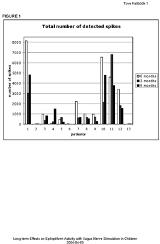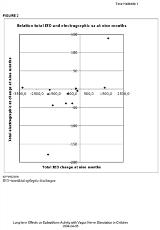LONG TERM EFFECT ON EPILEPTIFORM ACTIVITY WITH VAGUS NERVE STIMULATION IN CHILDREN
Abstract number :
1.408
Submission category :
Year :
2004
Submission ID :
4436
Source :
www.aesnet.org
Presentation date :
12/2/2004 12:00:00 AM
Published date :
Dec 1, 2004, 06:00 AM
Authors :
1Tove Hallböök, 2Johan Lundgren, 3Gösta Blennow, 4Lars-Göran Strömblad, and 5Ingmar Rosén
We report long-term effects of Vagus Nerve Stimulation (VNS) on epileptiform activity in 15 children and how these changes are related to activity stage and to clinical effects on seizure reduction, seizure severity and quality of life (QOL). Before and after three and nine months of VNS-treatment 15 children were investigated with 24 hours ambulatory EEG monitoring for spike detection[italic]. [/italic]The number of interictal epileptiform discharges (IED) and the inter spike interval[rsquo]s (ISI) were analysed during two hours in the awake state, and one hour of rapid eye movement (REM)-, spindle- and delta-sleep, respectively. Total number and duration of electrographic seizures were also analysed. At nine months the total number of IED was significantly reduced (p=0.03).[figure1]There was a tendency of reduction in all activity stages and significantly so in REM (p=0.03) and delta-sleep (p=0.02). No significant changes of median ISI were found at three and nine months (p=0.27, 0.10). Total electrographic seizure number was significantly reduced in the 24 hours EEG at three and nine months (p=0.03, 0.05). There was a significant concordance in direction of changes in epileptiform activity and electrographic seizures at nine months [figure2] and a concordance in direction of changes in epileptiform activity and clinical effects on seizure reduction, seizure severity and QOL. However, there was no direct correlation between the extent of improvement in these clinical data and the degree of spike reduction. This study shows that VNS reduces IED especially in REM and delta sleep. It shows a reduction in electrographic seizure number. There is also a concordance between reduction in IED and electrographic seizures and in IED and effects on clinical seizure reduction, seizure severity and QOL. (Supported by Orion-Pharma, Linnéa och Josef Carlssons foundation, Margaretahemmets foundation, Stiftelsen Samaritens foundation, Segerfalks foundation and SRC#084)

